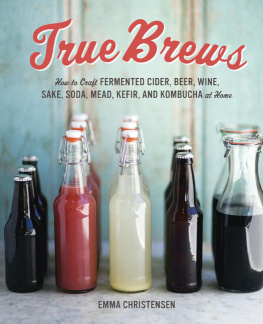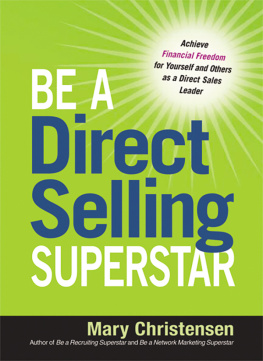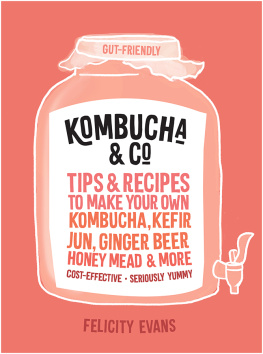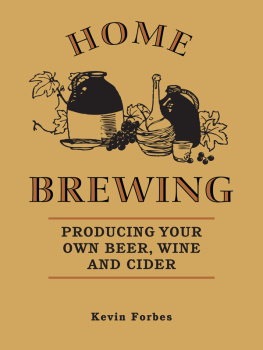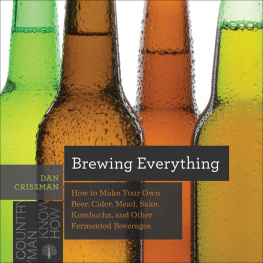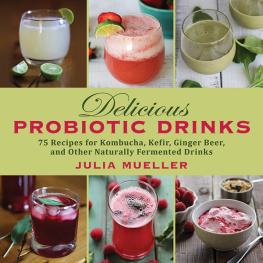Copyright 2013 by Emma Christensen
Photographs copyright 2013 by Paige Green
All rights reserved.
Published in the United States by Ten Speed Press, an imprint of the Crown Publishing Group, a division of Random House, Inc., New York.
www.crownpublishing.com
www.tenspeed.com
Ten Speed Press and the Ten Speed Press colophon are registered trademarks of Random House, Inc.
Library of Congress Cataloging-in-Publication Data
Christensen, Emma.
True brews : how to craft fermented cider, beer, wine, sake, soda, kefir, and kombucha at home / Emma Christensen. First edition.
pages cm
Includes index.
Summary: An accessible homebrew guide for alcoholic and non-alcoholic fermented drinks, including beer, mead, soda, kefir, kombucha, hard cider, sake, and fruit winesProvided by publisher.
1. BrewingAmateurs manuals. I. Title.
TP570.C56 2013
641.873dc23
2012034347
eBook ISBN: 9781607743392
Hardcover ISBN: 9781607743385
Food styling by Karen Shinto
Prop styling by Esther Feinman
by Danielle Tsi
v3.1
To Grandma Dola
Contents
Introduction
Lets set a few things straight: anyone can homebrew in any size apartment with a stockpot, a bucket, and a jug. I promise you this is true. You dont need a lot of space. You dont need fancy equipment. You wont stink up the apartment or be forced to hide homebrew in the bathtub. And as long as you use common sense, you dont need to worry about exploding bottles. You want to homebrew? Lets do it.
Sodas run the gamut from the simplest of ginger ales to the fanciest fancy-pants fresh fruit- and herb-infused sparklers. There are kombucha scobys and kefir grains that have traveled the world and back over the course of generations. Homebrewers and winemakers will argue into the wee hours about the merits of this brewing technique with that temperature variance and using this particular piece of hand-welded equipment.
But every single one of these brews, from that basic soda to the finest Pinot Noir, shares the same fundamental process. If you take a sugary liquid, add some yeast or friendly bacteria, and let it sit for a while without bothering it, this beverage will transform into something fizzy, flavorful, and quite often, alcoholic. That, my friends, is fermentation.
Sugary liquid + yeast (and the occasional friendly bacteria) + time = delicious fermented beverage
It really is that simple. Right this very minute, you could buy a gallon of grape juice from the store, add a teaspoon of yeast, and in a few weeks, youd have wine. Not very good wine, but wine nonetheless. If you want better wine, there are some details that need to be discussed. Lucky for you, those details are right here in this book.
I started brewing beer in 2009 with my husband. We were newly married and newly settled in a city far away from friends and family. We thought that brewing would be a dandy project to tackle as we settled into our new life together.
Our first batch was so terrible that we poured it straight down the drain. Our second batch was slightly better. Our third was downright drinkable. By our fourth, we had upgraded our equipment, collected a small library of brewing books, and reserved the domain name for our imaginary future brewpub: New Low Brewing Company. (Its tagline: When life reaches a new low, grab the beer thats right there with you!)
As was probably inevitable, I started looking around for more things that we could transform into alcohol using this magical process of fermentation. I grilled a friend about making mead and started obsessing over the idea of brewing sake. Yeast-carbonated sodas in recycled plastic bottles started collecting in our fridge. After a second move, this one to California, I discovered kombucha and kefir. I loved these beverages immediately for their snappy flavors and centuries-old fermentation processplus their payload of probiotics and antioxidants didnt hurt.
At a certain point, it became obvious: I was addicted to brewing. Which, in the larger scheme of things, is not really so terrible.
All of the recipes in this book are tailored to batches of 1 gallon or less. That goes for the equipment as well as the ingredients. I have only ever lived in small city apartments, and so I sympathize with the limits on kitchen and storage space.
Small batches are also good for learning the brewing process. Temperatures are easier to control, pots are easier to lift, and mistakes are easier to catch. And if a mistake does happen somewhere in the process, its less heartbreaking to part with 1 gallon of funky brew than 5 or more of them.
The Brewers Pantry, Brewers Toolbox, and Brewers Handbook sections are meant to introduce you to the basic ingredients, equipment, and procedures youll encounter in the recipes that follow. Flip through them before you get started so you know what youre shopping for. Later on, use these sections for refining your skills and tweaking your process.
The ensuing chapters start with the easiest and quickest brewing recipes and move gradually to the more lengthy: soda pop, kombucha, kefir, hard cider, beer, mead, sake, and fruit wine. Interviews with some of the top brewers and artisan makers in the country kick off each chapter, giving you expert advice and inspiration as you dive into your own brewing projects.
The master recipes are there to guide you through the individual quirks and procedures for each brew in extensive detail. They are also your template for making your own recipes. If you discover an abandoned apricot tree or find yourself unable to resist a flat of olallieberries at the farmers market, you can adapt your bounty to these master recipes and feel confident in the results.

